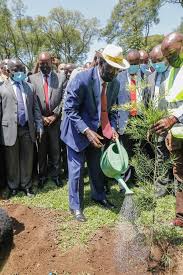Contact : +254 725 877 146
Raila Odinga’s Battle for the Mau Forest: A Lasting Environmental Legacy
The Premier told the settlers to ignore the forceful eviction order and instead wait for the establishment of an inter-ministerial committee that will spearhead the restoration of the water tower.

As Kenya and the world pause to mourn the passing of Rt. Hon. Raila Amolo Odinga, a towering figure in Africa’s political landscape and a fierce champion of democracy, there is another legacy less often told but equally profound: his unwavering commitment to environmental stewardship. This legacy defines a man who, beyond his political achievements, understood deeply that a nation’s future was inseparable from the health of its land and waters. Nowhere is this more evident than in his courageous, and at times controversial, crusade to save the Mau Forest Complex, Kenya’s largest water tower and ecological heartland.
Long before climate change became the rallying cry of global summits, Raila Odinga spoke with clarity and urgency about the interconnectedness of nature and national survival. Forests, rivers, and biodiversity were not distant concerns or political talking points to him; they were the very lifeblood of Kenya’s economy, security, and people’s wellbeing. “The health of a nation depends on the health of its people and its environment,” observed Mohamed Adow, a renowned climate expert, reflecting on Odinga’s vision. For Raila, protecting the environment was not a luxury, it was a moral imperative entwined with the battle against poverty and inequality.
This philosophy faced its sternest test in 2009 during his tenure as Prime Minister in the Grand Coalition Government, when decades of lawlessness and neglect had pushed the Mau Forest to the brink of ecological collapse. Illegal logging, rampant deforestation, and settlement had ravaged this once vast forest, imperiling rivers that feed Lake Victoria, the Mara ecosystem, and millions of farmers and pastoralists downstream. The Mau was bleeding, and with it, Kenya’s economic future.
Raila Odinga’s response was bold and decisive. He spearheaded one of the country’s most daring and contentious conservation efforts: the eviction of thousands of illegal settlers from the forest reserve. This move was met with fierce resistance, accusations of ethnic bias, and intense political backlash. But Odinga stood firm, driven by a vision that transcended politics. “You cannot destroy the forests that feed our rivers and expect to survive,” he declared at a rally in Narok, calmly dismissing tribal rhetoric. “Protecting the Mau is not about tribe or politics; it’s about our children’s tomorrow.”
Environmental policy scholar Dr. Judith Nyambura lauds this stance, saying, “Raila took an unpopular decision because he understood that without water, Kenya’s economy, its very survival, was at risk. It was leadership shaped by principle rather than popularity.” His was a lonely stand in a political landscape often dominated by short-term gains, where politicians shy away from confronting powerful interests or making unpopular decisions. Yet Raila recognized that the farmer facing drought, the family displaced by climate change, and every citizen suffering from water scarcity shared a common fate arising from environmental neglect.
Beyond eviction orders, Raila’s government launched an ambitious restoration initiative, establishing the Mau Forest Restoration Secretariat tasked with coordinating rehabilitation efforts. The journey was neither smooth nor easy. Challenges ranged from socio-political tensions to logistical hurdles. Still, over the years, thousands of hectares of degraded forest have begun to regenerate. River flows have stabilized, wetlands revived, and hope rekindled in communities once facing ecological despair.
Raila’s vision extended beyond just the Mau Forest. As someone deeply connected to the Lake Victoria region, he championed the fight against the invasive water hyacinth, which choked fisheries and handicapped livelihoods. He called for regional collaboration between Kenya, Uganda, and Tanzania, highlighting that ecological challenges recognize no borders. His efforts mobilized cleanup projects and innovative responses to restore the health of East Africa’s largest freshwater lake.
On the global stage, Raila Odinga was a passionate advocate for climate justice. He consistently challenged developed nations to honor their “climate debt,” urging them to provide meaningful support to Africa as the continent faces disproportionate climate impacts despite having contributed least to the problem. At a major environmental forum in Nairobi in 2024, he remarked, “Africa contributes the least to climate change, yet we suffer the most. The Global North must not only pay its climate debt; it must partner with Africa to build a sustainable future.”
Championing Kenya’s green energy transition, Raila backed geothermal, wind, and other renewable energy sources, seeing them as keys to modernizing the economy while protecting the environment. He also promoted environmental accountability at county government levels, proposing incentives for local governments that excel in forest restoration, clean energy adoption, and pollution control, emphasizing that “development without sustainability is self-destruction.”
Prof. Peter Kamau, an environmental historian, encapsulates Raila’s unique contribution: “Leadership is not always about popularity but about standing firm on principle. Raila chose to defend the Mau Forest when silence was easier and popular. Thanks to his courage, Kenya’s rivers, lakes, and forests still breathe today.”
As we honor the memory of this remarkable leader, the whispering leaves of the regenerating Mau Forest stand as a living monument to his vision and bravery. Raila Odinga’s fight for the Mau was ultimately a fight for Kenya’s soul—a reminder that true leadership sometimes means planting the seeds of hope and resilience for generations yet unborn. His legacy challenges us all to act with equal courage for the environment that sustains us.

